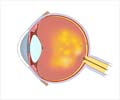Consuming western dietary patterns, one defined as high in consumption of red and processed meat, refined grains, fried food, and high-fat dairy, may be a risk factor for developing late-stage age-related macular degeneration (AMD).

‘Late stage age-related macular degeneration (AMD), an irreversible condition that affects a person's central vision, taking away their ability to drive, among other common daily activities.’
Read More..




"Treatment for late, neovascular AMD is invasive and expensive, and there is no treatment for geographic atrophy, the other form of late AMD that also causes vision loss. It is in our best interest to catch this condition early and prevent development of late AMD," said Shruti Dighe, who conducted the research at the University at Buffalo in the US. Read More..
The results suggest that that a Western dietary pattern may be a risk factor for developing late AMD.
However, a Western diet was not associated with development of early AMD in the study, published in the British Journal of Ophthalmology.
The authors studied the occurrence of early and late AMD over approximately 18 years of follow-up among participants of the Atherosclerosis Risk in Communities (ARIC) Study which was designed to investigate the etiology and clinical outcomes of atherosclerosis, a disease in which plaque builds up inside your arteries.
Dighe and her colleagues used data on 66 different foods that participants self-reported consuming between 1987 and 1995 and identified two diet patterns in this cohort -- Western and what researchers commonly refer to as "prudent" (healthy) -- that best explained the greatest variation between diets.
Advertisement
Early AMD is asymptomatic, meaning that people often do not know that they have it. To catch it, a physician would have to review a photo of the person's retina, looking for pigmentary changes and development of drusen, or yellow deposits made up of lipids.
Advertisement
"When people start developing these changes they will begin to notice visual symptoms. Their vision will start diminishing," said Dighe, who is now pursuing her PhD in cancer sciences at Roswell Park Comprehensive Cancer Center in Buffalo, New York.
"This is advanced or late stage AMD," she said.
Source-IANS















